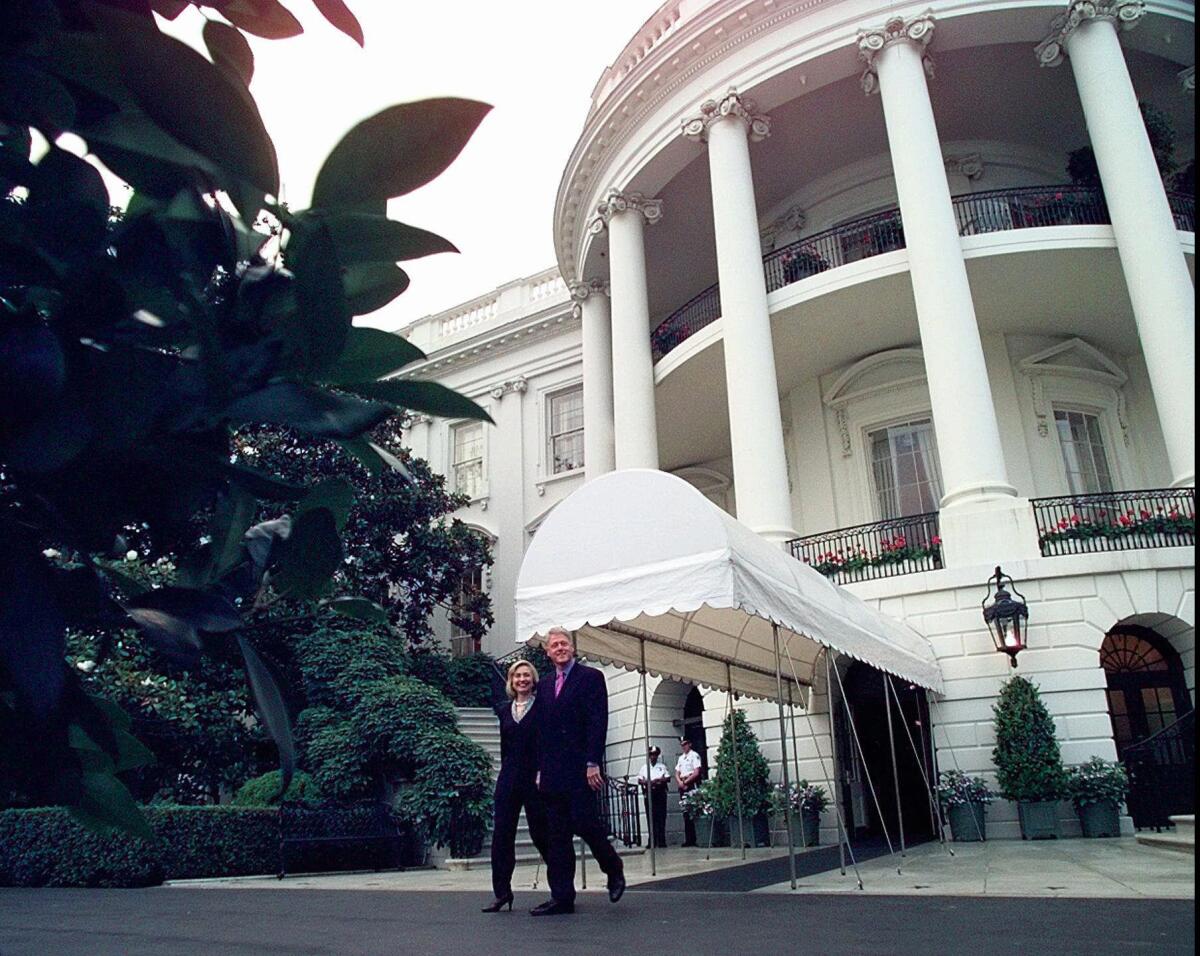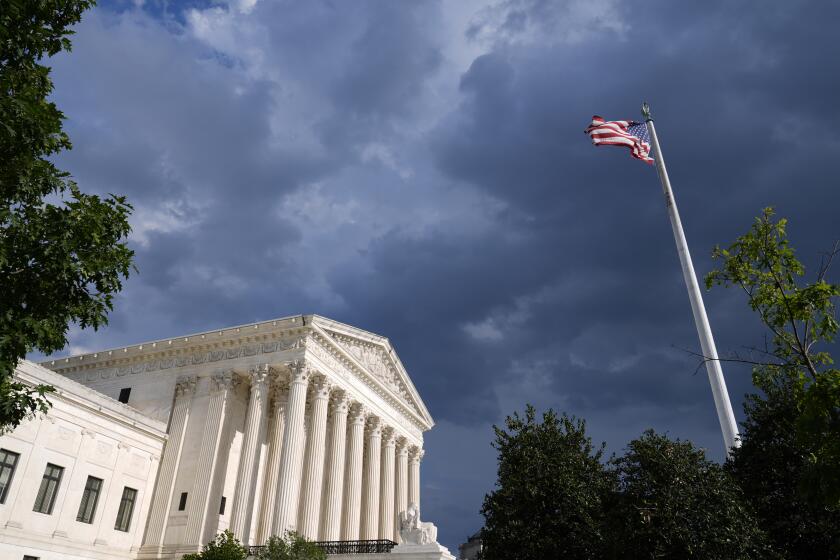For Hillary Rodham Clinton, archives evoke fiery White House years

- Share via
Hillary Rodham Clinton has been basking in the glow of good news for months.
Poll after poll shows her towering over the 2016 Republican field. She has been warmly received at her paid speeches (with the exception of that flying shoe). She has a glossy new cover for her June 10 memoir. And her daughter told the world Thursday that the former first lady, senator and secretary of State will become a grandmother this fall.
So the latest batch of archived documents from the Clinton White House -- while not particularly newsworthy -- were a rather bracing reminder that the very mellow former first lady has emerged in her current happy state after many years in a White House that often took on the tone of war zone.
Mark that down as one reason why Clinton might not want to go racing back.
Friday’s release of some 7,000 documents that were sealed under the Presidential Records Act did not uncover much new ground about Clinton’s role as first lady. (The papers, part of a collection of some 33,000 pages, were sealed for more than 12 years under the act because they contained confidential advice or information related to federal appointments).
The documents once again underscored the combative fashion in which the Clinton White House drove its agenda, and its obsession with the administration’s adversaries.
One unsigned and undated document contained in the files of Jane Sherburne, a Special Counsel to the White House between 1994 and 1996, details theories about how the right wing, with the help of think tanks and conservative publications, was funneling “fringe” stories to the media. It also expounds on the financial powers and connections of billionaire Richard Mellon Scaife, who was referred to as “The Wizard of Oz.”
Part of the problem, the memo suggested, was the fact that the Internet “allows an extraordinary amount of unregulated data and information to be located in one area and available to all.”
“The right wing has seized upon the Internet as a means of communicating its ideas to people,” the unsigned memo continues. “Moreover evidence exists that Republican staffers surf the Internet interacting with extremists in order to exchange ideas and information.”
It’s unclear what importance the memo held (or who even read it). But White House concerns about Scaife and his allies during those years are well documented.
And during a more combative phase of her career in January 1998, Clinton famously defended her husband by suggesting on NBC that a “vast right-wing conspiracy” had been plotting against Bill Clinton since he first announced his desire to run for the presidency.
The fierce advocacy for the Clinton agenda and warlike tone of some of the administration’s advisors crops up throughout many of the advisory memos to the president in Friday’s archive collection, which covered topics as disparate as the Oklahoma City bombing and the Internet broadcast of the 1998 White House Easter Egg Roll.
There are extensive polling documents looking at how issues were playing, and which ones might help President Clinton shore up his standing with the American people, along with lots of advice on how to push back against unfavorable press coverage.
Among the most intensive of the administration’s battles was Hillary Clinton’s effort to pass healthcare legislation, which ultimately collapsed. There are reams of memos and charts detailing the concerns of each lawmaker the White House was targeting to support the legislation. (By coincidence, among the members they hoped to persuade was Chelsea Clinton’s future mother-in-law, then-Rep. Marjorie Margolies of Pennsylvania.)
And no detail was too small as the team strategized about how to win over their targets. Sen. Nancy Kassebaum of Kansas, one memo noted, had an elderly mother who lived at home and might have a particular interest in long-term care. The first lady was often dispatched to make the case.
With a healthcare “war room” up and running, and an “active field campaign in the works,” a White House aide divided major players into the healthcare debate into five categories, including allies and “enemies,” in one memo to the first lady.
Another memo in the first lady’s files outlined the political strategy for passing health reform. The administration would have to hold all liberal and moderate Democrats, attracting 8 to 10 moderate Republicans in the Senate and between 15 to 20 in the House. They planned to negotiate member by member, offering policy changes “which the member can claim to have won.”
In the process, they would directly take on the healthcare legislation’s foes, the unsigned memo said in all capital letters: “We should not attack Republican members, with the exception of the far right members, like Senator [Phil] Gramm, but we should attack their principles and supporters. We must and can discredit the conservative Republican philosophy which says there is no problem and proposes no solution.”
“They are out to destroy health reform and will never be with us,” the memo concluded. “Destroying them makes it easier for moderate Republicans and conservative Democrats to support a modified version of our plan.”
When the plan ultimately collapsed, some of the frustration was directed back at White House staff. “I see the inside when I think of how disloyal some administration officials have been to you and the president and how hurtful they have been to me in their private discussions with the press,” advisor Ira Magaziner wrote the first lady in mid-1995 when he was updating her on his discussions for a book that covered the failed healthcare initiative.
Ultimately, Magaziner told her, he decided not to reveal information that would cast their colleagues in a bad light -- partly because of political considerations. “Although it is tempting, I just don’t feel it’s right to do and it could sew [sic] discord in 1996 when the book appears, which would not be helpful to the campaign.”
Many years beyond the healthcare debacle, Hillary Clinton showed her steely resolve again in 2008 when she ran for the presidency against Barack Obama in what then seemed like an interminable test of wills. But these days she brushes lightly over her past travails, explaining that she’s learned to listen to criticism, but not take it personally.
Whether she could carry that more mellow tone into a second Clinton White House remains an open question. But in the hyper-partisan environment in Washington, it’s surely one that’s on her mind.
Twitter: @MaeveReston
More to Read
Get the L.A. Times Politics newsletter
Deeply reported insights into legislation, politics and policy from Sacramento, Washington and beyond. In your inbox twice per week.
You may occasionally receive promotional content from the Los Angeles Times.











